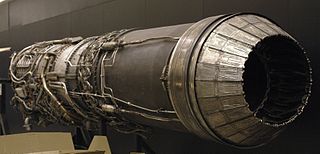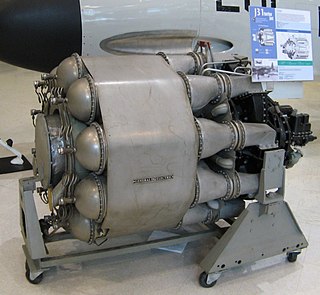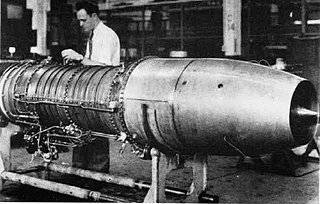| AM-3 | |
|---|---|
 | |
| Type | Turbojet |
| National origin | Soviet Union |
| Designer | Alexander Mikulin |
| Major applications | |
The Mikulin AM-3 (also called RD-3M) was a turbojet engine developed in the Soviet Union by Alexander Mikulin. [1]
| AM-3 | |
|---|---|
 | |
| Type | Turbojet |
| National origin | Soviet Union |
| Designer | Alexander Mikulin |
| Major applications | |
The Mikulin AM-3 (also called RD-3M) was a turbojet engine developed in the Soviet Union by Alexander Mikulin. [1]
The development of the high-performance single-shaft engine began in 1948. The engine was used in different versions for the Tupolev Tu-16 and Tu-104, as well as the Myasishchev M-4. It had a single-stage low-pressure and an eight-stage high-pressure compressor, powered by a two-stage high-pressure turbine.
Comparable engines
Related lists

The Pratt & Whitney J57 is an axial-flow turbojet engine developed by Pratt & Whitney in the early 1950s. The J57 was the first 10,000 lbf (45 kN) thrust class engine in the United States. The J57/JT3C was developed into the J52 turbojet, the J75/JT4A turbojet, the JT3D/TF33 turbofan, and the XT57 turboprop. The J57 and JT3C saw extensive use on fighter jets, jetliners, and bombers for many decades.

The General Electric J79 is an axial-flow turbojet engine built for use in a variety of fighter and bomber aircraft and a supersonic cruise missile. The J79 was produced by General Electric Aircraft Engines in the United States, and under license by several other companies worldwide. Among its major uses was the Lockheed F-104 Starfighter, Convair B-58 Hustler, McDonnell Douglas F-4 Phantom II, North American A-5 Vigilante and IAI Kfir.

The General Electric/Allison J35 was the United States Air Force's first axial-flow compressor jet engine. Originally developed by General Electric in parallel with the Whittle-based centrifugal-flow J33, the J35 was a fairly simple turbojet, consisting of an eleven-stage axial-flow compressor and a single-stage turbine. With the afterburner, which most models carried, it produced a thrust of 7,400 lbf (33 kN).

The Pratt & Whitney J52 is an axial-flow dual-spool turbojet engine originally designed for the United States Navy, in the 40 kN class. It powered the A-6 Intruder and the AGM-28 Hound Dog cruise missile. As of 2021 the engine was still in use in models of the A-4 Skyhawk.

The Snecma Atar is a French axial-flow turbojet engine built by Snecma. It was derived from the German World War II BMW 018 design, and developed by ex-BMW engineers through a progression of more powerful models. The name is derived from its original design group, Atelier technique aéronautique de Rickenbach near Lindau within the French Occupation Zone of Germany. The Atar powered many of the French post-war jet aircraft, including the Vautour, Étendard and Super Étendard, Super Mystère and several models of the Mirage.

The Wright J65 was an axial-flow turbojet engine produced by Curtiss-Wright under license from Armstrong Siddeley. A development of the Sapphire, the J65 powered a number of US designs.

The Tumansky R-11 is a Soviet Cold War-era turbojet engine.

The Tumansky R-13 is a Soviet turbojet engine designed by Sergei Alekseevich Gavrilov.

The Lyulka AL-7 was a turbojet designed by Arkhip Mikhailovich Lyulka and produced by his Lyulka design bureau. The engine was produced between 1954 and 1970.

The Tumansky RD-9 was an early Soviet turbojet engine, not based on pre-existing German or British designs. The AM-5, developed by scaling down the AM-3, was available in 1952 and completed testing in 1953; it produced 25.5 kN (5,700 lbf) thrust without afterburner. The AM-5 engine is notable for making possible the first mass-produced supersonic interceptors such as the MiG-19, and the first Soviet all-weather area interceptor, the Yak-25. When Sergei Tumansky replaced Alexander Mikulin as the OKB-24's chief designer in 1956, the engine was renamed RD-9. The engine was later built under license in China as the WP-6.

The General Electric J31 was the first jet engine to be mass-produced in the United States.

The Tumansky R-15 is an axial flow, single shaft turbojet with an afterburner. Its best known use is on the Mikoyan-Gurevich MiG-25.

The Armstrong Siddeley ASA.1 Adder was an early British turbojet engine developed by the Armstrong Siddeley company and first run in November 1948.

The CFE CFE738 is a small turbofan engine aimed at the business/commuter jet market manufactured by the CFE Company, and is used on the Dassault Falcon 2000.

The Pratt & Whitney J48 is a turbojet engine developed by Pratt & Whitney as a license-built version of the Rolls-Royce Tay. The Tay/J48 was an enlarged development of the Rolls-Royce Nene.

The Turbomeca Aubisque was a small turbofan engine designed and produced by Turbomeca in the 1960s. Its only application was the Saab 105 military trainer aircraft as the RM9. The engine is named after the Col d'Aubisque in the Pyrenees mountains, in line with company tradition.

The Westinghouse J30, initially known as the Westinghouse 19XB, was a turbojet engine developed by Westinghouse Electric Corporation. It was the first American-designed turbojet to run, and only the second axial-flow turbojet to run outside Germany.

The General Electric J73 turbojet was developed by General Electric from the earlier J47 engine. Its original USAF designation was J47-21, but with innovative features including variable inlet guide vanes, double-shell combustor case, and 50% greater airflow was redesignated J73. Its only operational use was in the North American F-86H.

The STAL Dovern was a Swedish turbojet design of the early 1950s, named after a lake in Finspång municipality in Östergötland, Sweden. Intended to power the Saab 35 Draken, this aircraft was powered by the Rolls-Royce Avon instead. The Dovern did not enter production.

The Dobrynin RD-7 or "VD-7" is a Soviet single-shaft axial-flow turbojet engine, which was produced in a small series. "RD" means реактивный двигатель. Designed by designer Vladimir Alekseevich Dobrynin, it was intended for installation on the Myasishchev Type 103 strategic bomber.
| | This aircraft engine article is missing some (or all) of its specifications. If you have a source, you can help Wikipedia by adding them. |